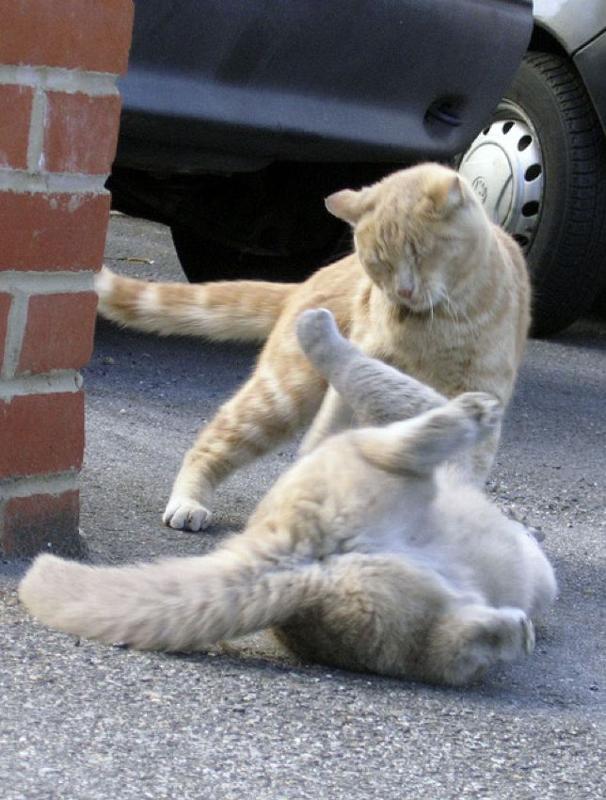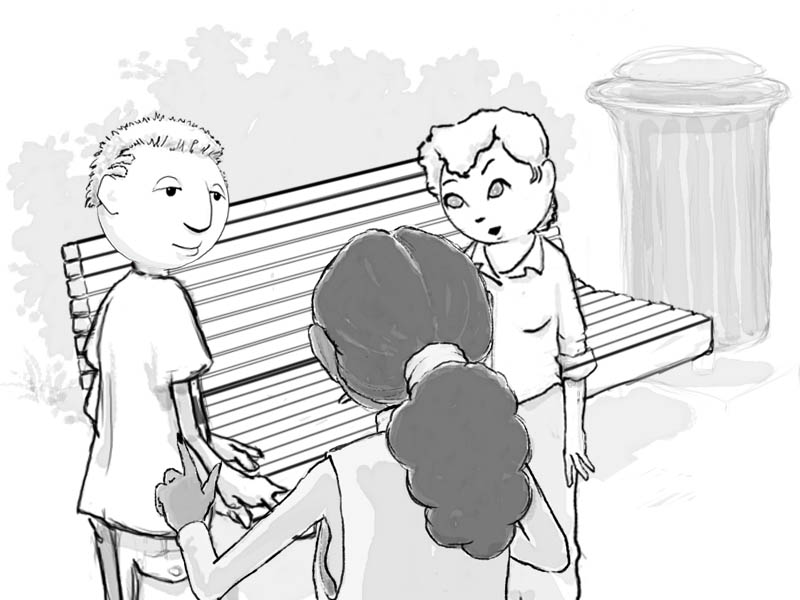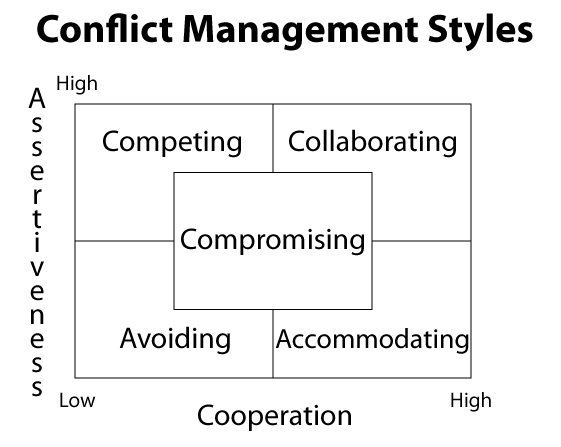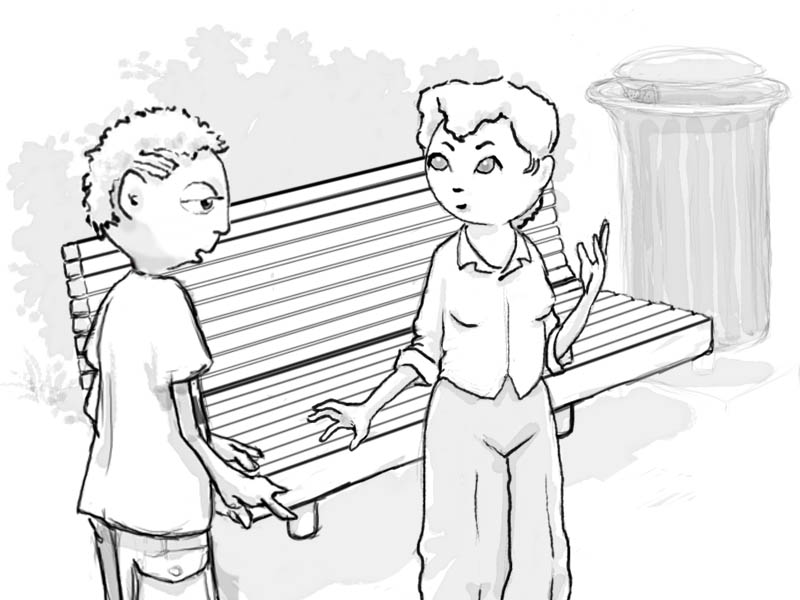
iStudy for Success!
Online learning tutorials for essential college skills.

Conflict can have both positive and negative consequences. When conflict is not managed properly, it can be destructive and ruin relationships by creating some dissenting feelings. Unmanaged conflict can create feelings of opposition not only in the people directly experiencing the conflict, but also in people observing - or even hearing about - the conflict. However, when conflict is properly managed, it can be healthy. Learning to manage conflict is a necessary skill for all aspects of life.
There is not one single method for handling conflict. Each situation may call for a different method to manage it. Combining conflict management techniques, with good communication skills, facilitates effective conflict management.
In this tutorial, you will learn some reasons for conflict, why you should be concerned with managing disputes, and five conflict-handling modes. These skills will help you to manage and understand conflict in your everyday life, with friends and family, and with situations that may arise during school and/or work.
Upon completion of this tutorial, you will be able to:
To complete this tutorial, first, read the material on conflict management and the student conversation about handling conflict. As you read, think about how you handle conflict, and complete the activities.
Note: All external links in this tutorial will open in a new window or tab.
 Deena: Heather, I'm really glad that Sage invited you to that meeting a few weeks ago.
Deena: Heather, I'm really glad that Sage invited you to that meeting a few weeks ago.
Brian: Oh yeah! I was just thinking about when Heather first showed up. You weren't too thrilled about her taking Lori's place.
Deena: Brian, I admit I did have some problems with Heather at first, but things are just fine now.
Brian: What was your problem with Heather?
Deena: I think what bothered me the most was that Lori left out of nowhere. I was really upset by that and I took it out on Heather. I couldn't help thinking to myself that Heather was intruding on our group. I mean, what right did she have to take Lori's place?
Brian: So your problem was with someone who wasn't even there?
Deena: Exactly. So I acted really sarcastic to everything Heather said and I think I sort of avoided her.
Brian: And how did you feel about that, Heather?
Heather: Well, to tell you the truth, I didn't really want to come back to the group after that first meeting, but Sage explained the situation to me.
Deena: I'm glad you came back.
Brian: Oh, isn't that sweet? Now we're all one big, happy family.
Deena: Seriously, Brian. It's really important that the conflict between Heather and me was resolved. Actually, this story brings up a good point. We're going to be dealing with conflict for the rest of our lives, and it's important that we learn how how to deal with it.
 Brian: I think I see what you are saying about the importance of learning to manage conflict.
Brian: I think I see what you are saying about the importance of learning to manage conflict.
Deena: Uh-huh. In a perfect world we'd never argue with anyone, but this is not a perfect world. We also have to recognize that everyone we meet is not going to be like us. Just look around any classroom. More than ever, there are students from different places with different beliefs and ways of looking at things.
Brian: So, with all these different people, we're more likely to get into some kinds of conflicts.
Deena: I don't think that you have to go global to find extreme diversity.
Brian: For sure.
Deena: This may come as no surprise to you, but being in a situation like this team could cause a conflict.
Brian: I guess the whole team thing can cause some problems.
Deena: Well, think about it. A family is a lot like a team, and what family doesn't have its share of conflicts?
Brian: True. It seems like the closer people work together, the easier it is for them to annoy each other.
Deena: I see conflict everyday when I go to my classes. In most of my courses, I'm the oldest one there. In one course, some of the students asked me why I was taking the course and others thought I was the TA. At first I didn't think too much about it, until I overheard one of them say it would be different having an older person taking the class. My first thought was to get really defensive. After all, I'm 32 and that is not old. Besides, the young girl who said that is always popping her gum, which is very distracting and really bugs me.
Brian: One thing is for sure; conflict is part of everyday life and it's not going to go away. I think we really need to be aware of it and sharpen our skills to manage it.
Deena: Yeah, just like in class. If we let conflict affect our group, then it could also affect others in the class. And the instructor may not even let students work together in future classes.
Brian: That could mean a lot more work for each individual, not to mention the learning experiences that would be lost.
Check your understanding by completing the short quiz below.

The Thomas Kilmann conflict mode instrument, or TKI, is frequently used in conflict resolution training and identifies five distinct modes that people use to handle conflict (Thomas & Kilman). Understanding your conflict handling style may help you handle future conflicts more effectively.

See if you can identify the conflict-handling modes used in each of these situations below.

 We are becoming a global society. However, even while we benefit from increasing diversity, our differences create more opportunities for conflict:
We are becoming a global society. However, even while we benefit from increasing diversity, our differences create more opportunities for conflict:
In today's world, we're working in teams more frequently. There are teams in the classrooms and teams in the workplace. Collaboration is happening everywhere. Unfortunately, when people work closely together, conflict can frequently occur.
When people work closely together, they also get to know each other better. Sometimes when you know people on a deeper level, some of the things they do get on your nerves, and the next thing you experience is conflict.
 Deena: I think we should take the time now and review what we have learned about conflict management. So, what can we do to manage conflict? What are the five conflict-handling modes?
Deena: I think we should take the time now and review what we have learned about conflict management. So, what can we do to manage conflict? What are the five conflict-handling modes?
Brian: You mean like "Avoiding" and "Accommodating?"
Deena: Listening to you makes me think of "Competing." Remember when Heather first joined the group? I sort of felt like she was competing for Lori's place in our group.
Brian: And "Compromising." Sometimes I think we give in to each other too easily. Sort of like an easy way out. But I also like to think we are "Collaborating." You know, being highly assertive and highly cooperative.
Deena: Yeah. But is it the best way to manage the conflict that occurs?
Brian: While we don't agree on everything, we are learning to get along better.
Deena: We have our different viewpoints, but are expressing them better. The more we practice conflict management, the better we get at it.
Brian: Applying good listening skills with conflict management skills really puts us on a successful path with our research assignment. Good communication and managing conflicts should help us get to where we need to go sooner.
Deena: I agree, but we have just looked at one method of managing conflict. I think the main point is to recognize when conflict occurs and do something before it becomes a problem.
[top of page]
As you know, there is no one right way to handle conflict every time. Each situation may call for a different way to manage disputes. The more you practice managing friction in a group, the better you'll become. When you combine conflict-handling techniques with some of the communication skills you've already learned, like body language techniques, listening skills, not interrupting, acknowledging feelings, and providing good feedback, you'll be on the way to effective conflict management.
* Indicates that the original Website is no longer available.
 Remember:
Remember:
Collaborating is an attempt for both people to work things out. The assertive, yet cooperative, collaborator takes care of his/her needs as well as the needs of others without compromising, or giving something up. The collaborator says, "Let's both keep discussing this until we can reach consensus, then we'll both 'win'," and tries to understand where the other person is coming from in order to arrive at a win-win situation. Because neither party loses anything, collaboration is the best way to manage conflict but it is also the most time-consuming method.
Compromising means each person gives or loses something in an attempt to create a win-win situation by trying to take care of his/her needs as well as the needs of others. The compromiser attempts to cooperate, but not at his/her personal expense. The compromiser says, "let's see if we can work this out."
Accommodating means someone gives in to the conflict, and sacrifices personal needs to satisfy others. This conflict-handling mode usually indicates a person who is relatively unassertive but very cooperative - a person who hopes for "peace at all costs."
Competing involves an assertive, and often uncooperative, person who will push to get what he or she wants. The competitor takes care of his/her needs first, caring little for the needs of others and says, "me first at all costs."
Avoiding means that at least one person opts out of the situation leaving their needs unmet, or their thoughts unshared. This conflict-handling mode usually indicates the person who is avoiding is less inclined to be assertive and/or cooperative.
The following assignments are embedded in the Conflict Management tutorial:
This tutorial is related to other tutorials on personal effectiveness, including note-taking, active reading, time management, project management, interview skills, peer tutoring, and brainstorming.
In particular, conflict management utilizes skills and principles directly related to:
Break students into pairs or small groups, and have students discuss the type of conflict handling mode(s) they tend to utilize most often. Instruct students to reflect upon the reasons why they use a particular mode more than others. Conclude the activity by having each pair or group share the key points from their discussion, and expand upon those points in order to reinforce the main points presented in the tutorial content.
Note: This is an excellent opportunity to utilize and reinforce the cooperative learning techniques found in the Cooperative Learning Tutorial.
Provide students with a mock conflict situation and a conflict resolution tip sheet. Have them practice resolving the conflict by utilizing the tips.
Conflict is not singularly a good or bad thing. When conflict is not managed properly, it can be destructive and ruin relationships by creating negative feelings. This is true not only in the people directly experiencing the conflict, but also in the people observing the conflict or even hearing about the conflict. However, when conflict is properly managed, it can be healthy. Learning to manage conflict is a necessary skill for all aspects of life.
We are becoming a global society. However, even while we benefit from increasing diversity, our differences create more opportunities for conflict:
In today's world, we're working in teams more frequently. There are team dynamics in the classrooms and workplace. Collaboration is happening everywhere. Unfortunately, when people work closely together, conflict can occur more frequently.
When people work closely together, they also get to know each other better. Sometimes when you know people on a more personal basis, some of the things they do get on your nerves, and the next thing you experience is conflict.
Through observing both the group's and the individual's activity, the instructor may assess student performance. Assessment criteria are as follows (Instructors supply the percentage weights):
|
Where |
Domain |
Activities |
% |
|---|---|---|---|
|
iStudy Tutorial |
Knowledge |
The learner can identify the reasons for conflict by referring to possible sources of conflicts. |
|
|
iStudy Tutorial |
Comprehension |
The learner can describe the importance of managing conflict by giving his/her examples or experiences related to conflict. |
|
|
iStudy Tutorial |
Application |
The learner can apply five modes of handling conflict into new problem context after personally interpreting and distinguishing them. |
|
|
|
|
|
100% |